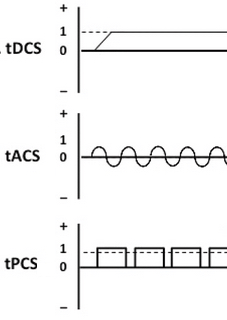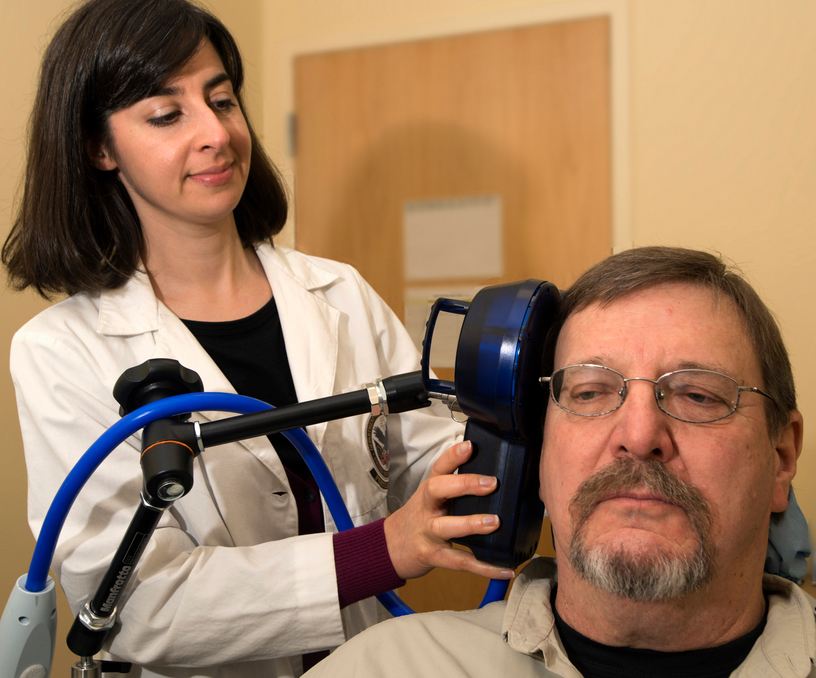Could this new electrical brain-zap method help you learn muscle skills faster?
July 17, 2015

Three electrical brain-stimulation methods. Vertical axis: current-flow intensity; horizontal axis: time. (adapted from Shapour Jaberzadeh et al./PLOS ONE)
Researchers headed by Shapour Jaberzadeh and his group at Monash University have discovered a new noninvasive technique that could rev up your brain to improve your physical performance — for athletes and musicians, for instance — and might also improve treatments for brain-related conditions such as stroke, depression, and chronic pain.
The two neuroelectrical treatment methods currently in use are transcranial direct current simulation (tDCS) — low intensity direct current (direct current is what a battery creates) — and transcranial alternating current simulation (tACS) — current that constantly changes and reverses polarity (alternating current, or AC, is used in houses and buildings).
Introducing transcranial pulsed current stimulation
The newest method, called transcranial pulsed current stimulation (tPCS), increases more corticospinal (muscle-movement-related) excitability, according to the researchers.
“We discovered that this new treatment produced larger excitability changes in the brain,” said Jaberzadeh. In addition, increasing the length of the pulse and decreasing the [time] interval between pulses heightened excitability even further.
The research is described in a paper published Wednesday (July 15) in the open-access journal PLOS ONE.
“When we learn a task during movement training (for example playing the piano), gradually our performance gets better. This improvement coincides with enhancement of the brain excitability. Compared to tDCS, our novel technique can play an important role in enhancement of the brain excitability, which may help recipients learn new tasks faster.”
Jaberzadeh said the technique had exciting implications for a whole host of conditions in which “enhancement of the brain excitability” has a therapeutic effect. These include training for treatment of stroke and other neurological disorders, mental disorders, and even management of pain.
“Our next step is to investigate the underlying mechanisms for the efficacy of this new technique. This will enable us to develop more effective protocols for application of tPCS in patients with different pathological conditions.”
One side effect of the treatment: the patient sees lights flashing in their eyes (retinal phosphenes) — actually a plus for trippers.
New tinnitus treatment uses TMS

Transcranial magnetic stimulation being applied for tinnitus by Sarah Theodoroff, Ph.D., assistant professor of Otolaryngology/Head and Neck Surgery at OHSU (credit: VA Portland Health Care System/OHSU)
In related neuromodulation news, transcranial magnetic stimulation (TMS) significantly improved tinnitus symptoms for more than half of study participants in recent research at the VA Portland Medical Center and Oregon Health & Science University.
“For some study participants, this was the first time in years that they experienced any relief in symptoms,” according to the the researchers.
The study was funded by the Veterans Administration and published in the journal JAMA Otolaryngology — Head & Neck Surgery.
Tinnitus affects nearly 45 million Americans. People with this condition hear a persistent sound that can range from ringing or buzzing to a hissing or white noise hum when there is no external sound source. Currently, there are no proven treatments available.
Currently, the Food and Drug Administration has only approved transcranial magnetic stimulation for treatment of depression.
Abstract of Anodal Transcranial Pulsed Current Stimulation: The Effects of Pulse Duration on Corticospinal Excitability
The aim is to investigate the effects of pulse duration (PD) on the modulatory effects of transcranial pulsed current (tPCS) on corticospinal excitability (CSE). CSE of the dominant primary motor cortex (M1) of right first dorsal interosseous muscle was assessed by motor evoked potentials, before, immediately, 10, 20 and 30 minutes after application of five experimental conditions: 1) anodal transcranial direct current stimulation (a-tDCS), 2) a-tPCS with 125 ms pulse duration (a-tPCSPD = 125), 3) a-tPCS with 250 ms pulse duration (a-tPCSPD = 250), 4) a-tPCS with 500 ms pulse duration (a-tPCSPD = 500) and 5) sham a-tPCS. The total charges were kept constant in all experimental conditions except sham condition. Post-hoc comparisons indicated that a-tPCSPD = 500 produced larger CSE compared to a-tPCSPD = 125(P<0.0001), a-tPCSPD = 250 (P = 0.009) and a-tDCS (P = 0.008). Also, there was no significant difference between a-tPCSPD = 250 and a-tDCS on CSE changes (P>0.05). All conditions except a-tPCSPD = 125 showed a significant difference to the sham group (P<0.006). All participants tolerated the applied currents. It could be concluded that a-tPCS with a PD of 500ms induces largest CSE changes, however further studies are required to identify optimal values.
Abstract of Repetitive Transcranial Magnetic Stimulation Treatment for Chronic Tinnitus: A Randomized Clinical Trial
Importance Chronic tinnitus negatively affects the quality of life for millions of people. This clinical trial assesses a potential treatment for tinnitus.
Objectives To determine if repetitive transcranial magnetic stimulation (rTMS) can reduce the perception or severity of tinnitus and to test the hypothesis that rTMS will result in a statistically significantly greater percentage of responders to treatment in an active rTMS group compared with a placebo rTMS group.
Design, Setting, and Participants A randomized, participant and clinician or observer–blinded, placebo-controlled clinical trial of rTMS involving individuals who experience chronic tinnitus. Follow-up assessments were conducted at 1, 2, 4, 13, and 26 weeks after the last treatment session. The trial was conducted between April 2011 and December 2014 at Portland Veterans Affairs Medical Center among 348 individuals with chronic tinnitus who were initially screened for participation. Of those, 92 provided informed consent and underwent more detailed assessments. Seventy individuals met criteria for inclusion and were randomized to receive active or placebo rTMS. Sixty-four participants (51 men and 13 women, with a mean [SD] age of 60.6 [8.9] years) were included in the data analyses. No participants withdrew because of adverse effects of rTMS.
Interventions Participants received 2000 pulses per session of active or placebo rTMS at a rate of 1-Hz rTMS daily on 10 consecutive workdays.
Main Outcomes and Measures The Tinnitus Functional Index (TFI) was the main study outcome. Our hypothesis was tested by comparing baseline and posttreatment TFIs for each participant and group.
Results Overall, 18 of 32 participants (56%) in the active rTMS group and 7 of 32 participants (22%) in the placebo rTMS group were responders to rTMS treatment. The difference in the percentage of responders to treatment in each group was statistically significant (χ21 = 7.94, P < .005).
Conclusions and Relevance Application of 1-Hz rTMS daily for 10 consecutive workdays resulted in a statistically significantly greater percentage of responders to treatment in the active rTMS group compared with the placebo rTMS group. Improvements in tinnitus severity experienced by responders were sustained during the 26-week follow-up period. Before this procedure can be implemented clinically, larger studies should be conducted to refine treatment protocols.
Trial Registration clinicaltrials.gov Identifier: NCT01104207